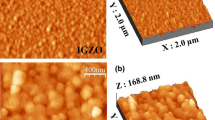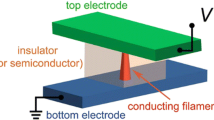Abstract
The effect of a defect concentration-modified top electrode on the bipolar resistance switching of transparent Al-doped ZnO/ZnO/ITO [AZO(TE)/ZnO/ITO(BE)] devices was investigated. Different oxygen vacancy concentrations in the top electrode, Al-doped ZnO, can be simply controlled by modulating the sputtering working pressure condition from 1.2 to 12 mTorr. The oxygen vacancy concentration between AZO and ZnO may trigger oxygen diffusion at the interface and affect the switching characteristic. High oxygen release from a ZnO resistive layer caused by excessive oxygen vacancy concentration at the top electrode is responsible for reducing the memory window as a result of reduced oxygen available to rupture the filament. Top electrode based on lower oxygen vacancy concentration has a higher memory window and an asymmetric resistive switching characteristic. However, all set of devices have excellent endurance of more than 104 cycles. This study showed that an Al-doped ZnO top electrode helps not only to achieve a transparent device but also to enhance memory properties by providing a suitable oxygen vacancy concentration.







Similar content being viewed by others
References
Minami T, Nanto H, Takata S (1984) Highly conductive and transparent aluminium doped zinc oxide thin films prepared by RF magnetron sputtering. Jpn J Appl Phys 23:L280–L282. doi:10.1143/JJAP.23.L280
Tang MH, Jiang B, Xiao YG, Zeng ZQ, Wang ZP, Li JC, He J (2012) Top electrode-dependent resistance switching behaviors of ZnO thin films deposited on Pt/Ti/SiO2/Si substrate. Microelectron Eng 93:35–38. doi:10.1016/j.mee.2011.12.003
Peng HY, Li GP, Ye JY, Wei ZP, Zhang Z, Wang DD, Xing GZ, Wu T (2010) Electrode dependence of resistive switching in Mn-doped ZnO: filamentary versus interfacial mechanisms. Appl Phys Lett 96:192113. doi:10.1063/1.3428365
Xu D, Xiong Y, Tang M, Zeng B (2013) Top electrode-dependent resistance switching behaviors of lanthanum-doped ZnO film memory devices. Appl Phys A 114:1377–1381. doi:10.1007/s00339-013-7994-7
Chen M-C, Chang T-C, Tsai C-T, Huang S-Y, Chen S-C, Hu C-W, Sze SM, Tsai M-J (2010) Influence of electrode material on the resistive memory switching property of indium gallium zinc oxide thin films. Appl Phys Lett 96:262110. doi:10.1063/1.3456379
Panda D, Tseng T-Y (2013) One-dimensional ZnO nanostructures: fabrication, optoelectronic properties, and device applications. J Mater Sci 48:6849–6877. doi:10.1007/s10853-013-7541-0
Misra P, Das AK, Kukreja LM (2010) Switching characteristics of ZnO based transparent resistive random access memory devices grown by pulsed laser deposition. Phys Status Solidi 7:1718–1720. doi:10.1002/pssc.200983244
Cao X, Li X, Gao X, Liu X, Yang C, Yang R, Jin P (2011) All-ZnO-based transparent resistance random access memory device fully fabricated at room temperature. J Phys D 44:255104. doi:10.1088/0022-3727/44/25/255104
Yu H, Kim M, Kim Y, Lee J, Kim K, Choi S, Cho S (2014) Al-doped ZnO as a switching layer for transparent bipolar resistive switching memory. Electron Mater Lett 10:321–324. doi:10.1007/s13391-013-3225-9
Yao I-C, Lee D-Y, Tseng T-Y, Lin P (2012) Fabrication and resistive switching characteristics of high compact Ga-doped ZnO nanorod thin film devices. Nanotechnology 23:145201. doi:10.1088/0957-4484/23/14/145201
Zhou H, Fang G-J, Zhu Y, Liu N, Li M, Zhao X-Z (2011) Flexible resistive switching memory based on Mn 0.20 Zn 0.80 O/HfO 2 bilayer structure. J Phys D 44:445101. doi:10.1088/0022-3727/44/44/445101
Waser R, Dittmann R, Staikov C, Szot K (2009) Redox-based resistive switching memories nanoionic mechanisms, prospects, and challenges. Adv Mater 21:2632–2663. doi:10.1002/adma.200900375
Shi L, Shang D, Sun J, Shen B (2009) Bipolar resistance switching in fully transparent ZnO:Mg-based devices. Appl Phys Express 2:101602. doi:10.1143/APEX.2.101602
Seo JW, Park J-W, Lim KS, Yang J-H, Kang SJ (2008) Transparent resistive random access memory and its characteristics for nonvolatile resistive switching. Appl Phys Lett 93:223505. doi:10.1063/1.3041643
Chen M-C, Chang T-C, Huang S-Y, Chen S-C, Hu C-W, Tsai C-T, Sze SM (2010) Bipolar resistive switching characteristics of transparent indium gallium zinc oxide resistive random access memory. Electrochem Solid-State Lett 13:H191. doi:10.1149/1.3360181
Kim A, Song K, Kim Y, Moon J (2011) All solution-processed, fully transparent resistive memory devices. ACS Appl Mater Interfaces 3:4525–4530. doi:10.1021/am201215e
Zheng K, Sun XW, Zhao JL, Wang Y, Yu HY, Demir HV, Teo KL (2011) An indium-free transparent resistive switching random access memory. IEEE Electron Dev Lett 32:797–799. doi:10.1109/LED.2011.2126017
Yang P-K, Chang W-Y, Teng P-Y, Jeng S-F, Lin S-J, Chiu P-W, He J-H (2013) Fully transparent resistive memory employing graphene electrodes for eliminating undesired surface effects. Proc IEEE 101:1732–1739. doi:10.1109/JPROC.2013.2260112
Lu JG, Ye ZZ, Zeng YJ, Zhu LP, Wang L, Yuan J, Zhao BH, Liang QL (2006) Structural, optical, and electrical properties of (Zn, Al)O films over a wide range of compositions. J Appl Phys 100:073714. doi:10.1063/1.2357638
Chang W-Y, Lai Y-C, Wu T-B, Wang S-F, Chen F, Tsai M-J (2008) Unipolar resistive switching characteristics of ZnO thin films for nonvolatile memory applications. Appl Phys Lett 92:022110. doi:10.1063/1.2834852
Kwon D-H, Kim KM, Jang JH, Jeon JM, Lee MH, Kim GH, Li X-S, Park G-S, Lee B, Han S, Kim M, Hwang CS (2010) Atomic structure of conducting nanofilaments in TiO2 resistive switching memory. Nat Nanotechnol 5:148–153. doi:10.1038/nnano.2009.456
Chen JY, Hsin CL, Huang CW, Chiu CH, Huang YT, Lin SJ, Wu WW, Chen LJ (2013) Dynamic evolution of conducting nanofilament in resistive switching memories. Nano Lett. doi:10.1021/nl4015638
Cullity BD, Stock SR (2001) Elements of X-ray diffraction. Prentice Hall, Upper Saddle River
Kim DK, Kim HB (2011) Room temperature deposition of Al-doped ZnO thin films on glass by RF magnetron sputtering under different Ar gas pressure. J Alloys Compd 509:421–425. doi:10.1016/j.jallcom.2010.09.047
Zhang Z, Bao C, Ma S, Zhang L, Hou S (2012) Effects of deposition power and pressure on the crystallinity of Al-doped ZnO thin films at glass substrates by low temperature RF magnetron sputtering. J Aust Ceram Soc 48(2):214–222
Chen M, Wang X, Yu YH, Pei ZL, Bai XD, Sun C, Huang RF, Wen LS (2000) X-ray photoelectron spectroscopy and auger electron spectroscopy studies of Al-doped ZnO films. Appl Surf Sci 158:134–140. doi:10.1016/S0169-4332(99)00601-7
Wang W, Feng Q, Jiang K, Huang J, Zhang X, Song W, Tan R (2011) Dependence of aluminum-doped zinc oxide work function on surface cleaning method as studied by ultraviolet and X-ray photoelectron spectroscopies. Appl Surf Sci 257:3884–3887. doi:10.1016/j.apsusc.2010.11.084
Young Jeong H, Kyu Kim S, Yong Lee J, Choi S-Y (2011) Role of interface reaction on resistive switching of metal/amorphous TiO2/Al RRAM devices. J Electrochem Soc 158:H979. doi:10.1149/1.3622295
Wang G, Long S, Yu Z, Zhang M, Li Y, Xu D, Lv H, Liu Q, Yan X, Wang M, Xu X, Liu H, Yang B, Liu M (2015) Impact of program/erase operation on the performances of oxide-based resistive switching memory. Nanoscale Res Lett. doi:10.1186/s11671-014-0721-2
Zhang M, Long S, Wang G, Xu X, Li Y, Liu Q, Lv H, Lian X, Miranda E, Suñé J, Liu M (2014) Set statistics in conductive bridge random access memory device with Cu/HfO2/Pt structure. Appl Phys Lett 105:193501. doi:10.1063/1.4901530
Long S, Lian X, Cagli C, Perniola L, Miranda E, Liu M, Suñé J (2013) A model for the set statistics of RRAM inspired in the percolation model of oxide breakdown. IEEE Electron Device Lett 34:999–1001. doi:10.1109/LED.2013.2266332
Liu KC, Tzeng WH, Chang KM, Wu CH (2010) The effect of plasma deposition on the electrical characteristics of Pt/HfOx/TiN RRAM device. Surf Coat Technol 205:S379–S384. doi:10.1016/j.surfcoat.2010.08.043
Gao S, Song C, Chen C, Zeng F, Pan F (2012) Dynamic processes of resistive switching in metallic filament-based organic memory devices. J Phys Chem C 116:17955–17959. doi:10.1021/jp305482c
Pan F, Gao S, Chen C, Song C, Zeng F (2014) Recent progress in resistive random access memories: materials, switching mechanisms, and performance. Mater Sci Eng R 83:1–59. doi:10.1016/j.mser.2014.06.002
Yang YC, Pan F, Liu Q, Liu M, Zeng F (2009) Fully room-temperature-fabricated nonvolatile resistive memory for ultrafast and high-density memory application. Nano Lett 9:1636–1643. doi:10.1021/nl900006g
Jacobi K, Zwicker G, Gutmann A (1984) Work function, electron affinity and band bending of zinc oxide surfaces. Surf Sci 141:109–125. doi:10.1016/0039-6028(84)90199-7
Lee H-Y, Wu B-K, Chern M-Y (2014) Study on the formation of zinc peroxide on zinc oxide with hydrogen peroxide treatment using X-ray photoelectron spectroscopy (XPS). Electron Mater Lett 10:51–55. doi:10.1007/s13391-013-2244-x
Kalaev D, Riess I (2013) On conditions leading to crossing of I-V curve in metal1 mixed-ionic–electronic-conductor metal2 devices. Solid State Ionics 241:17–24. doi:10.1016/j.ssi.2013.03.024
Acknowledgements
This work was supported by the Ministry of Science and Technology, Taiwan, under project NSC 102-2221-E009-134-MY3.
Author information
Authors and Affiliations
Corresponding author
Rights and permissions
About this article
Cite this article
Simanjuntak, F., Panda, D., Tsai, TL. et al. Enhancing the memory window of AZO/ZnO/ITO transparent resistive switching devices by modulating the oxygen vacancy concentration of the top electrode. J Mater Sci 50, 6961–6969 (2015). https://doi.org/10.1007/s10853-015-9247-y
Received:
Accepted:
Published:
Issue Date:
DOI: https://doi.org/10.1007/s10853-015-9247-y




